Abstract
Two hundred and 14 patients with chronic second degree heart block were seen and followed up in the Devon Heart Block and Bradycardia Survey between 1968 and 1982. The patients were divided into three groups according to the type of block. In group 1 there were 77 patients with Mobitz type I block (mean age 69 years), in group 2, 86 patients with Mobitz type II block (mean age 74 years), and in group 3, 51 with 2:1 or 3:1 block (mean age 75 years). The five year survival was similar in all groups, being 57%, 61%, and 53% in groups 1, 2, and 3 respectively. The presence or absence of bundle branch block did not appear to influence prognosis. In particular, patients in group 1 without bundle branch block did not fare any better than those in group 2 both with and without bundle branch block. One hundred and three of the patients were fitted with pacemakers, the proportion being greatest in group 2. In each group a significantly larger number of paced patients survived than unpaced. The five year survival for all the paced patients in the study was 78% compared with 41% for the unpaced. Since the paced patients were slightly younger than the unpaced two age matched groups of 74 patients each were selected from the paced and unpaced patients, but the five year survival of those paced was still significantly better. It is concluded that in the patients in the present study chronic Mobitz type I block has a similar prognosis to that of Mobitz type II block. Unpaced patients with both types did very badly, whereas those fitted with pacemakers had a five year survival similar to that expected for the normal population. These results refute the benign reputation of chronic Mobitz type I block and imply that patients with this condition should be considered for pacemaker implantation on similar criteria to those adopted for patients with higher degrees of block.
Full text
PDF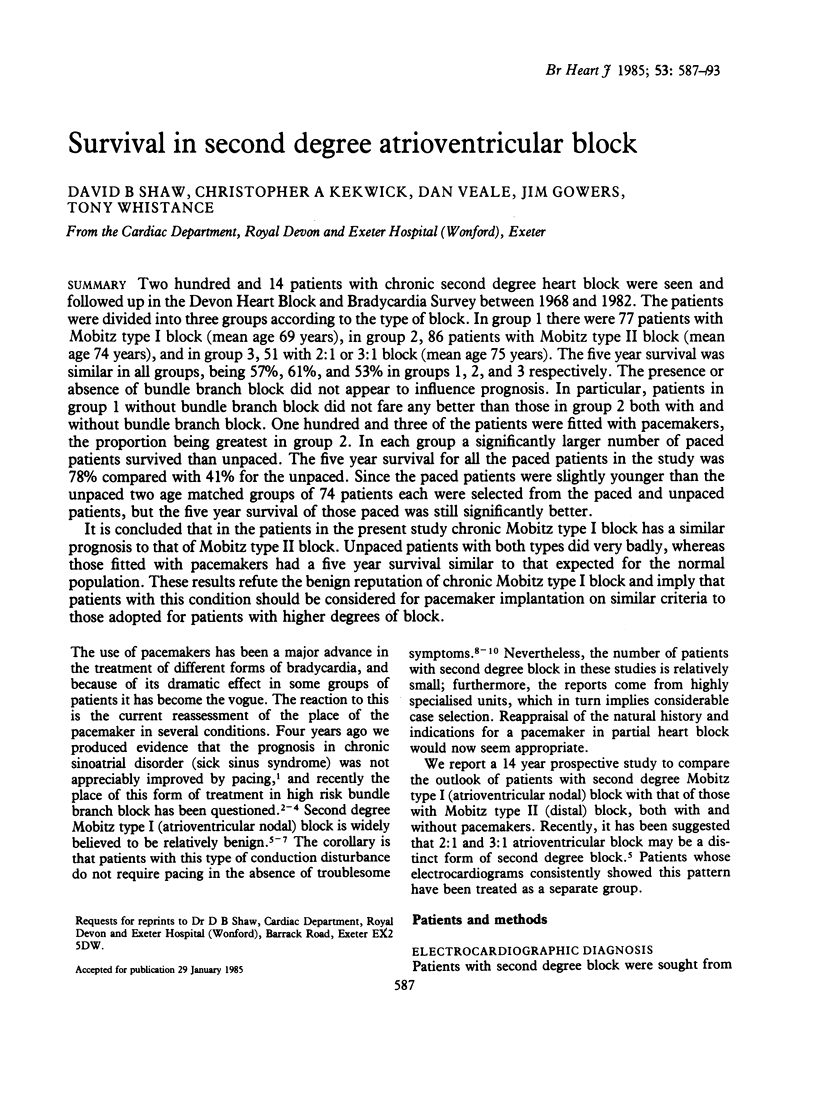
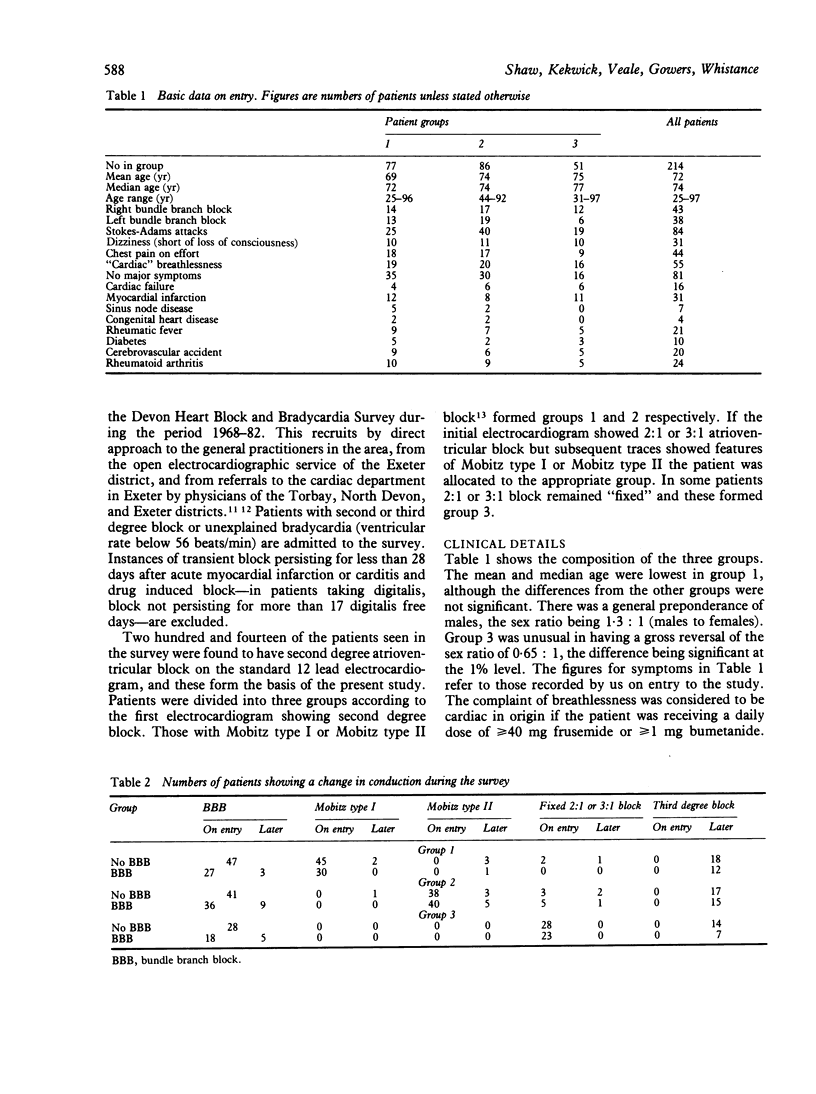
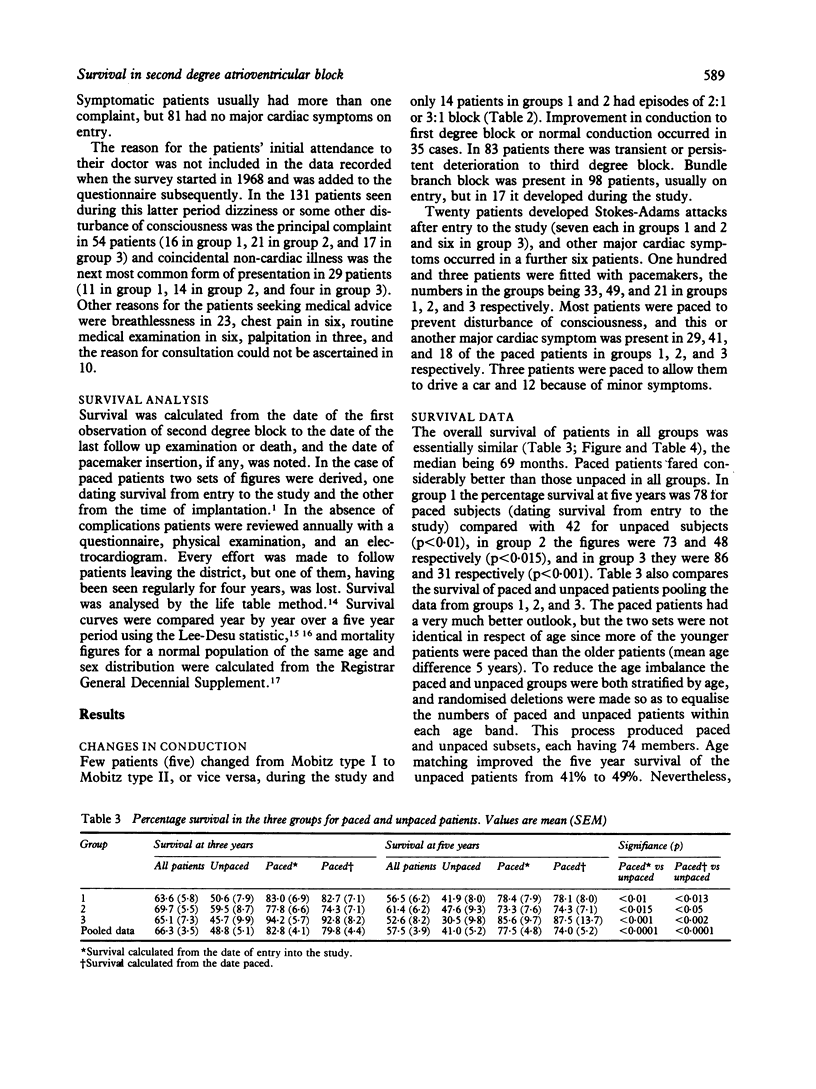
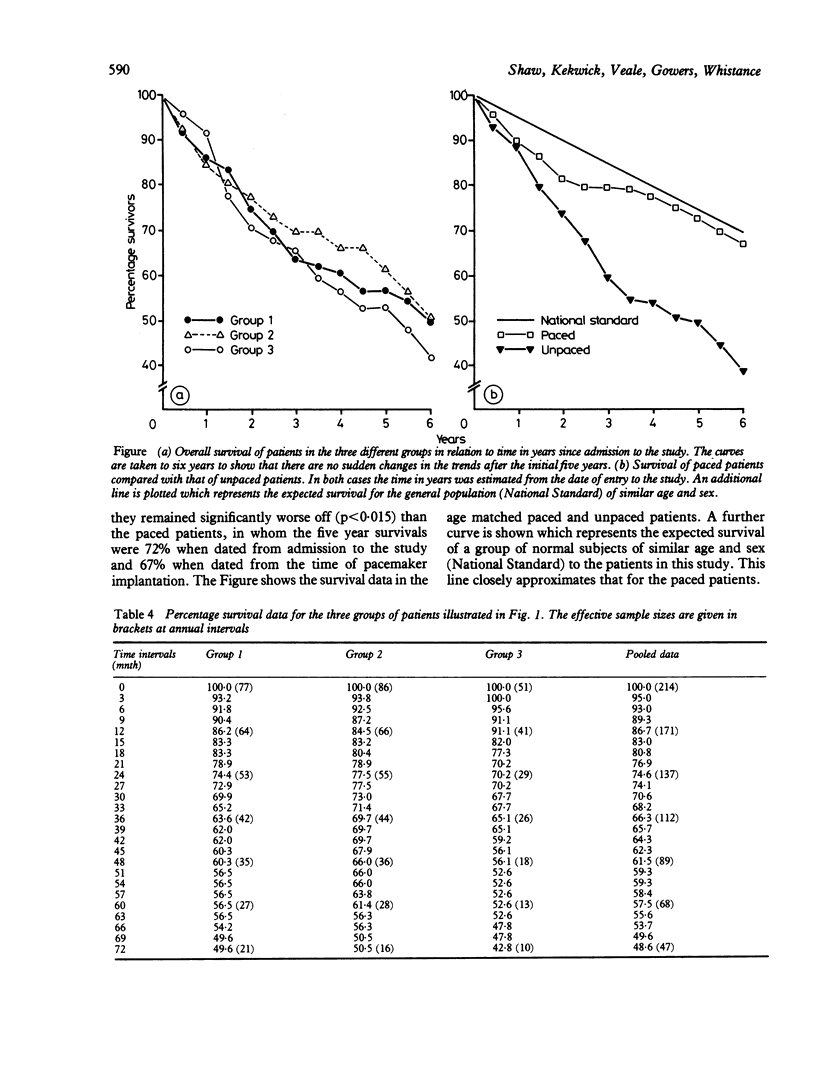
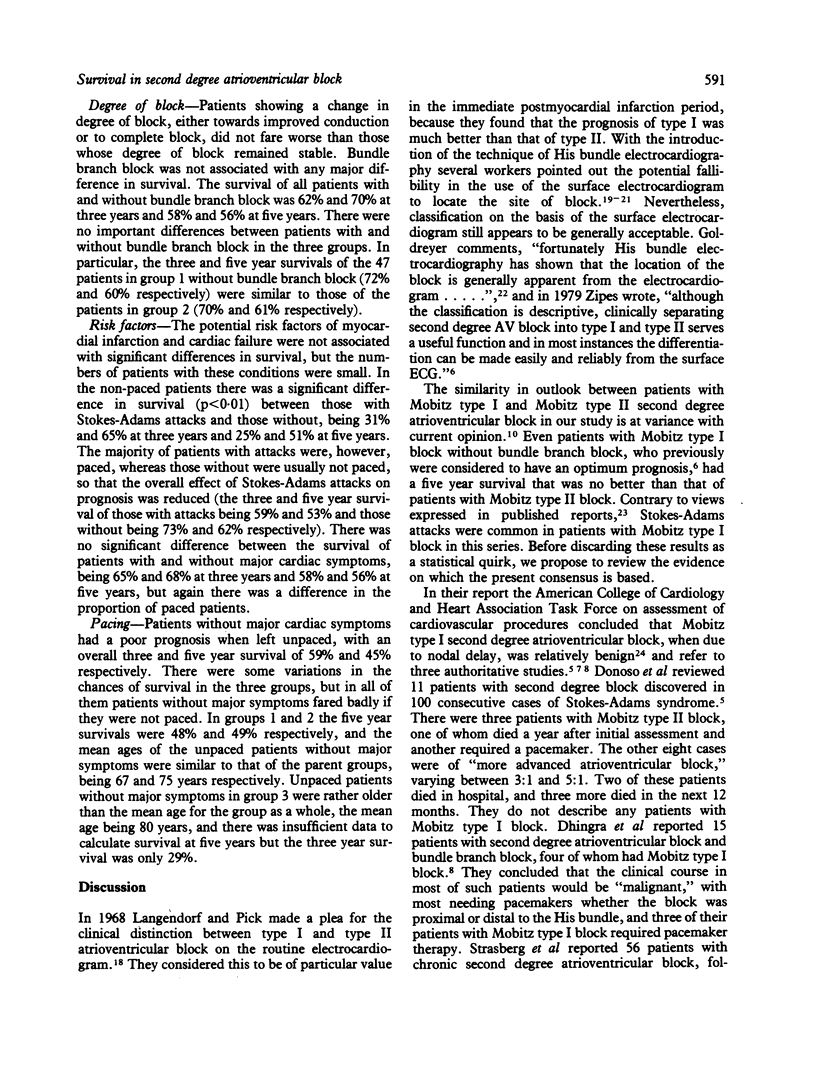
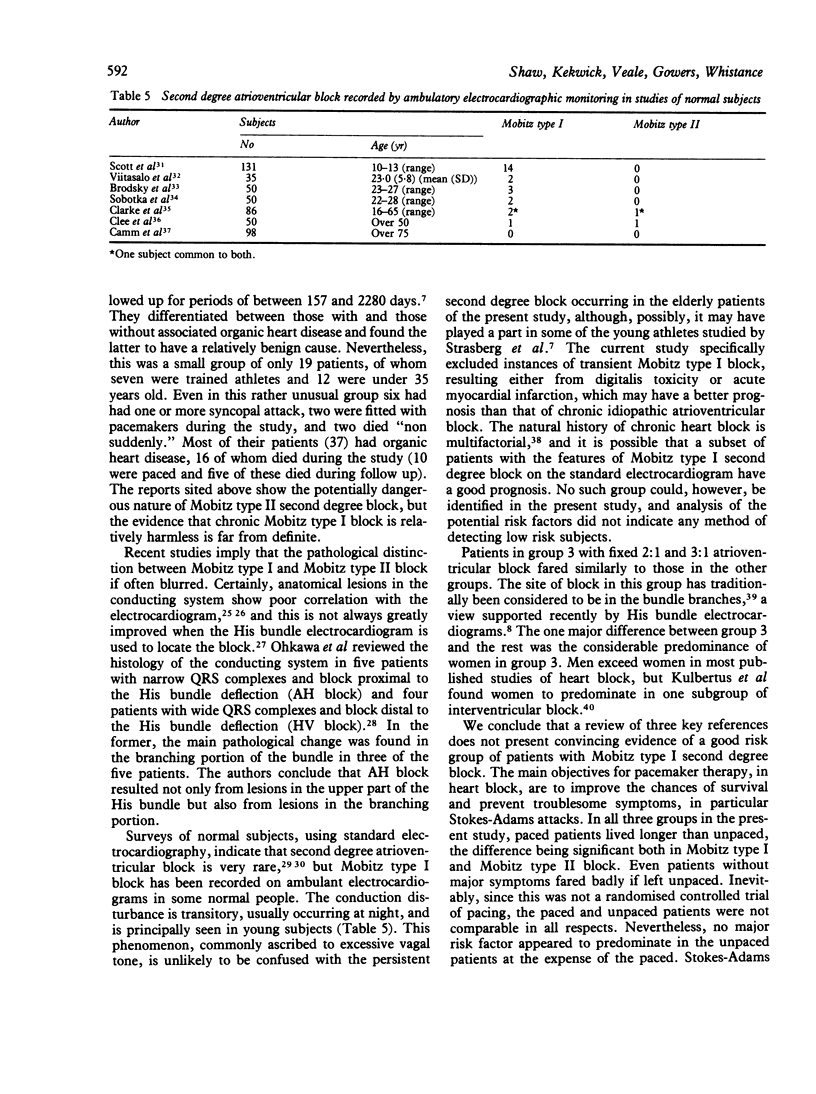
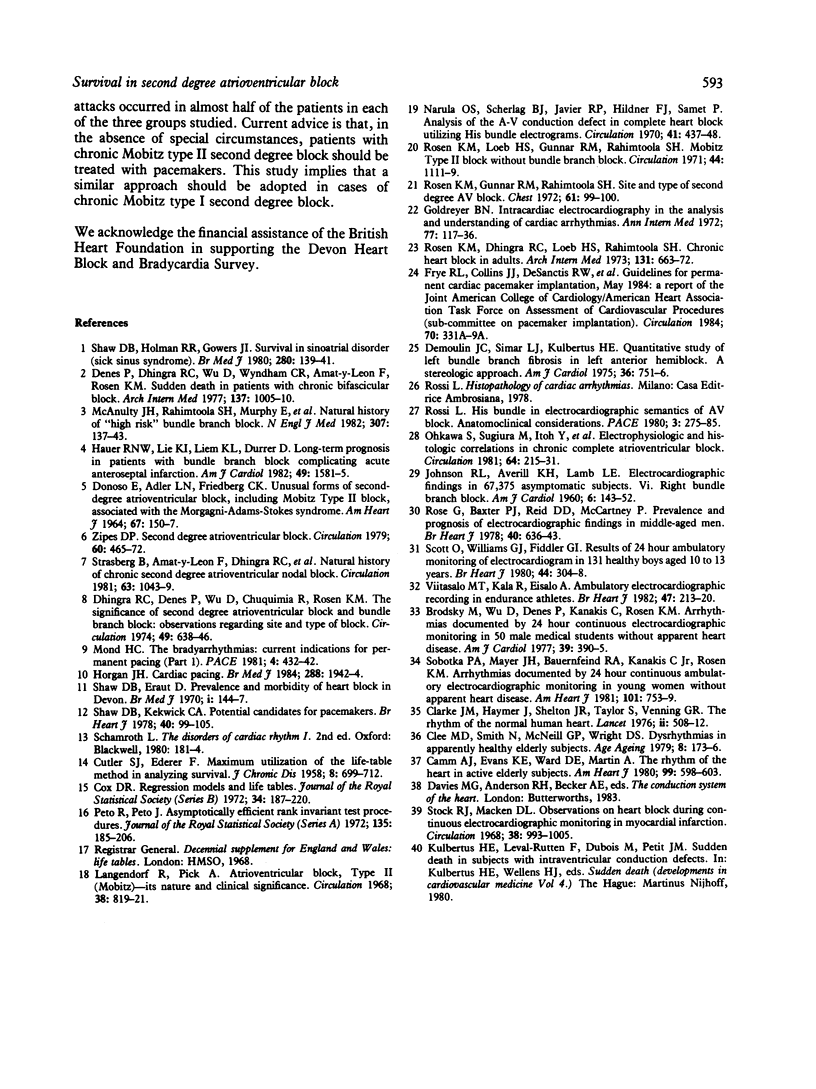
Selected References
These references are in PubMed. This may not be the complete list of references from this article.
- Brodsky M., Wu D., Denes P., Kanakis C., Rosen K. M. Arrhythmias documented by 24 hour continuous electrocardiographic monitoring in 50 male medical students without apparent heart disease. Am J Cardiol. 1977 Mar;39(3):390–395. doi: 10.1016/s0002-9149(77)80094-5. [DOI] [PubMed] [Google Scholar]
- CUTLER S. J., EDERER F. Maximum utilization of the life table method in analyzing survival. J Chronic Dis. 1958 Dec;8(6):699–712. doi: 10.1016/0021-9681(58)90126-7. [DOI] [PubMed] [Google Scholar]
- Camm A. J., Evans K. E., Ward D. E., Martin A. The rhythm of the heart in active elderly subjects. Am Heart J. 1980 May;99(5):598–603. doi: 10.1016/0002-8703(80)90733-4. [DOI] [PubMed] [Google Scholar]
- Clarke J. M., Hamer J., Shelton J. R., Taylor S., Venning G. R. The rhythm of the normal human heart. Lancet. 1976 Sep 4;1(7984):508–512. doi: 10.1016/s0140-6736(76)90801-1. [DOI] [PubMed] [Google Scholar]
- Clee M. D., Smith N., McNeill G. P., Wright D. S. Dysrhythmias in apparently healthy elderly subjects. Age Ageing. 1979 Aug;8(3):173–176. doi: 10.1093/ageing/8.3.173. [DOI] [PubMed] [Google Scholar]
- DONOSO E., ADLER L. N., FRIEDBERG C. K. UNUSUAL FORMS OF SECOND-DEGREE ATRIOVENTRICULAR BLOCK, INCLUDING MOBITZ TYPE-II BLOCK, ASSOCIATED WITH THE MORGAGNI-ADAMS-STOKES SYNDROME. Am Heart J. 1964 Feb;67:150–157. doi: 10.1016/0002-8703(64)90362-x. [DOI] [PubMed] [Google Scholar]
- Demoulin J. C., Simar L. J., Kulbertus H. E. Quantitative study of left bundle branch fibrosis in left anterior hemiblock: A stereologic approach. Am J Cardiol. 1975 Nov;36(6):751–756. doi: 10.1016/0002-9149(75)90456-7. [DOI] [PubMed] [Google Scholar]
- Denes P., Dhingra R. C., Wu D., Wyndham C. R., Amat-y-Leon F., Rosen K. M. Sudden death in patients with chronic bifascicular block. Arch Intern Med. 1977 Aug;137(8):1005–1010. [PubMed] [Google Scholar]
- Dhingra R. C., Denes P., Wu D., Chuquimia R., Rosen K. M. The significance of second degree atrioventricular block and bundle branch block. Observations regarding site and type of block. Circulation. 1974 Apr;49(4):638–646. doi: 10.1161/01.cir.49.4.638. [DOI] [PubMed] [Google Scholar]
- Goldreyer B. N. Intracardiac electrocardiography in the analysis and understanding of cardiac arrhythmias. Ann Intern Med. 1972 Jul;77(1):117–136. doi: 10.7326/0003-4819-77-1-117. [DOI] [PubMed] [Google Scholar]
- Hauer R. N., Lie K. I., Liem K. L., Durrer D. Long-term prognosis in patients with bundle branch block complicating acute anteroseptal infarction. Am J Cardiol. 1982 May;49(7):1581–1585. doi: 10.1016/0002-9149(82)90231-4. [DOI] [PubMed] [Google Scholar]
- Horgan J. H. Cardiac pacing. Br Med J (Clin Res Ed) 1984 Jun 30;288(6435):1942–1944. doi: 10.1136/bmj.288.6435.1942. [DOI] [PMC free article] [PubMed] [Google Scholar]
- JOHNSON R. L., AVERILL K. H., LAMB L. E. Electrocardiographic findings in 67,375 asymptomatic subjects. VI. Right bundle branch block. Am J Cardiol. 1960 Jul;6:143–152. doi: 10.1016/0002-9149(60)90043-6. [DOI] [PubMed] [Google Scholar]
- Kannel W. B., Thom T. J. Declining cardiovascular mortality. Circulation. 1984 Sep;70(3):331–336. doi: 10.1161/01.cir.70.3.331. [DOI] [PubMed] [Google Scholar]
- Langendorf R., Pick A. Atrioventricular block, type II (Mobitz)--its nature and clinical significance. Circulation. 1968 Nov;38(5):819–821. doi: 10.1161/01.cir.38.5.819. [DOI] [PubMed] [Google Scholar]
- McAnulty J. H., Rahimtoola S. H., Murphy E., DeMots H., Ritzmann L., Kanarek P. E., Kauffman S. Natural history of "high-risk" bundle-branch block: final report of a prospective study. N Engl J Med. 1982 Jul 15;307(3):137–143. doi: 10.1056/NEJM198207153070301. [DOI] [PubMed] [Google Scholar]
- Mond H. G. The bradyarrhythmias: current indications for permanent pacing (part I). Pacing Clin Electrophysiol. 1981 Jul;4(4):432–442. doi: 10.1111/j.1540-8159.1981.tb03723.x. [DOI] [PubMed] [Google Scholar]
- Narula O. S., Scherlag B. J., Javier R. P., Hildner F. J., Samet P. Analysis of the A-V conduction defect in complete heart block utilizing His bundle electrograms. Circulation. 1970 Mar;41(3):437–448. doi: 10.1161/01.cir.41.3.437. [DOI] [PubMed] [Google Scholar]
- Ohkawa S., Sugiura M., Itoh Y., Kitano K., Hiraoka K., Ueda K., Murakami M. Electrophysiologic and histologic correlations in chronic complete atrioventricular block. Circulation. 1981 Aug;64(2):215–231. doi: 10.1161/01.cir.64.2.215. [DOI] [PubMed] [Google Scholar]
- Rose G., Baxter P. J., Reid D. D., McCartney P. Prevalence and prognosis of electrocardiographic findings in middle-aged men. Br Heart J. 1978 Jun;40(6):636–643. doi: 10.1136/hrt.40.6.636. [DOI] [PMC free article] [PubMed] [Google Scholar]
- Rosen K. M., Dhingra R. C., Loeb H. S., Rahimtoola S. H. Chronic heart block in adults. Clinical and electrophysiological observations. Arch Intern Med. 1973 May;131(5):663–672. [PubMed] [Google Scholar]
- Rosen K. M., Gunnar R. M., Rahimtoola S. H. Site and type of second degree A-V block. Chest. 1972 Feb;61(2):99–100. doi: 10.1378/chest.61.2.99. [DOI] [PubMed] [Google Scholar]
- Rosen K. M., Loeb H. S., Gunnar R. M., Rahimtoola S. H. Mobitz type II block without bundle-branch block. Circulation. 1971 Dec;44(6):1111–1119. doi: 10.1161/01.cir.44.6.1111. [DOI] [PubMed] [Google Scholar]
- Rossi L. His bundle in electrocardiographic semantics of AV block. Anatomoclinical considerations. Pacing Clin Electrophysiol. 1980 May;3(3):275–285. doi: 10.1111/j.1540-8159.1980.tb05234.x. [DOI] [PubMed] [Google Scholar]
- Scott O., Williams G. J., Fiddler G. I. Results of 24 hour ambulatory monitoring of electrocardiogram in 131 healthy boys aged 10 to 13 years. Br Heart J. 1980 Sep;44(3):304–308. doi: 10.1136/hrt.44.3.304. [DOI] [PMC free article] [PubMed] [Google Scholar]
- Shaw D. B., Eraut D. Prevalence and morbidity of heart block in Devon. Br Med J. 1970 Jan 17;1(5689):144–147. doi: 10.1136/bmj.1.5689.144. [DOI] [PMC free article] [PubMed] [Google Scholar]
- Shaw D. B., Holman R. R., Gowers J. I. Survival in sinoatrial disorder (sick-sinus syndrome). Br Med J. 1980 Jan 19;280(6208):139–141. doi: 10.1136/bmj.280.6208.139. [DOI] [PMC free article] [PubMed] [Google Scholar]
- Shaw D. B., Kekwick C. A. Potential candidates for pacemakers. Survey of heart block and sinoatrial disorder (sick sinus syndrome). Br Heart J. 1978 Feb;40(2):99–105. doi: 10.1136/hrt.40.2.99. [DOI] [PMC free article] [PubMed] [Google Scholar]
- Sobotka P. A., Mayer J. H., Bauernfeind R. A., Kanakis C., Jr, Rosen K. M. Arrhythmias documented by 24-hour continuous ambulatory electrocardiographic monitoring in young women without apparent heart disease. Am Heart J. 1981 Jun;101(6):753–759. doi: 10.1016/0002-8703(81)90611-6. [DOI] [PubMed] [Google Scholar]
- Stock R. J., Macken D. L. Observations on heart block during continuous electrocardiographic monitoring in myocardial infarction. Circulation. 1968 Nov;38(5):993–1005. doi: 10.1161/01.cir.38.5.993. [DOI] [PubMed] [Google Scholar]
- Strasberg B., Amat-Y-Leon F., Dhingra R. C., Palileo E., Swiryn S., Bauernfeind R., Wyndham C., Rosen K. M. Natural history of chronic second-degree atrioventricular nodal block. Circulation. 1981 May;63(5):1043–1049. doi: 10.1161/01.cir.63.5.1043. [DOI] [PubMed] [Google Scholar]
- Viitasalo M. T., Kala R., Eisalo A. Ambulatory electrocardiographic recording in endurance athletes. Br Heart J. 1982 Mar;47(3):213–220. doi: 10.1136/hrt.47.3.213. [DOI] [PMC free article] [PubMed] [Google Scholar]
- Zipes D. P. Second-degree atrioventricular block. Circulation. 1979 Sep;60(3):465–472. doi: 10.1161/01.cir.60.3.465. [DOI] [PubMed] [Google Scholar]


